If you are a business owner looking to take your business to the next level, then an ecommerce website could be the right solution for you. Ecommerce web development is the process of creating an online store that allows businesses to sell their products or services to customers worldwide. In this article, we will cover the definition of ecommerce web development, the importance of ecommerce websites for businesses, and the key benefits of having an ecommerce website.
Definition of Ecommerce Web Development

Ecommerce web development is the process of creating a website that enables businesses to sell their products or services online. This includes everything from designing and developing the website to setting up payment gateways and shipping options. Ecommerce websites are different from regular websites because they require more complex functionalities, such as online shopping carts, product catalogs, and inventory management systems.
Importance of Ecommerce Websites for Businesses
In today’s digital age, having an ecommerce website has become a necessity for businesses of all sizes. Here are some reasons why:
- Expanded Reach: Ecommerce websites allow businesses to reach customers worldwide, which is not possible with traditional brick-and-mortar stores.
- Increased Sales: Ecommerce websites enable businesses to sell their products or services 24/7, which can significantly increase sales and revenue.
- Cost-Effective: Ecommerce websites are more cost-effective than physical stores because they don’t require rent, utilities, and other expenses associated with maintaining a physical store.
- Improved Customer Experience: Ecommerce websites offer a convenient and personalized shopping experience for customers, which can lead to increased customer satisfaction and loyalty.
Key Benefits of Ecommerce Websites
- Increased Sales: Ecommerce websites provide businesses with an additional sales channel, which can increase sales and revenue.
- Better Customer Insights: Ecommerce websites provide businesses with valuable customer data, such as purchasing behavior, demographics, and preferences, which can be used to improve marketing strategies and product offerings.
- Cost-Effective: Ecommerce websites are more cost-effective than traditional stores because they don’t require rent, utilities, and other expenses associated with maintaining a physical store.
- Increased Brand Awareness: Ecommerce websites provide businesses with a platform to showcase their brand and products, which can increase brand awareness and customer engagement.
Visit Here: History & Evolution Of Ecommerce Website Development
Planning Your Ecommerce Web Development

The first step in your ecommerce web development is to plan carefully. This includes defining your website’s goals, identifying your target audience, and conducting market research. Here are some key factors to consider during the planning phase:
- Choose the right ecommerce platform: There are many ecommerce platforms available, such as Wcart, Webnexs, and more. Choose the one that best fits your business needs and budget.
- Decide on the website design: The design of your ecommerce website is crucial because it affects the user experience and brand perception. Consider hiring a professional web designer to create a visually appealing and user-friendly website.
- Create a content strategy: Develop a content strategy that includes product descriptions, blog posts, and other content that can drive traffic to your website and improve search engine rankings.
Identifying your target audience and their needs
Understanding your target audience is essential to the success of your ecommerce website. Identify your target audience and their needs by conducting market research, analyzing customer data, and creating buyer personas. This information will help you tailor your website’s design, content, and marketing strategies to meet your customer’s needs and preferences.
Defining your ecommerce website’s goals and objectives
Setting clear goals and objectives is critical to the success of your ecommerce web development. Some common goals include increasing sales, improving customer satisfaction, and expanding your customer base. Make sure your goals are specific, measurable, and achievable within a given timeframe.
Conducting market research and competitor analysis
Market research and competitor analysis are crucial steps in developing your ecommerce website. These activities can help you identify market trends, customer preferences, and your competitor’s strengths and weaknesses. Use this information to refine your website’s design, content, and marketing strategies to stay ahead of the competition.
Read More: How To Build An Online Store
Choosing Your Ecommerce Platform
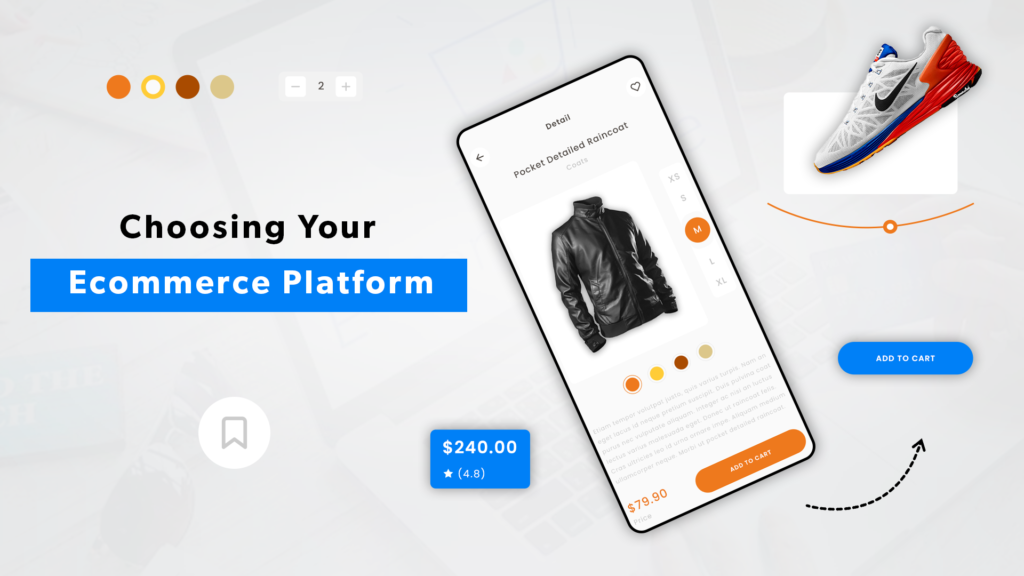
Before choosing an ecommerce platform, consider your business needs and budget. Some key factors to consider include:
- Type of products: Some ecommerce platforms are better suited for physical products, while others are designed for digital products.
- Payment options: Choose an ecommerce platform that offers the payment options your customers prefer.
- Customization: If you have specific design or functionality requirements, choose an ecommerce platform that allows customization.
Comparison of Popular Ecommerce Platforms
There are many ecommerce platforms available, but some of the most popular ones include:
Wcart
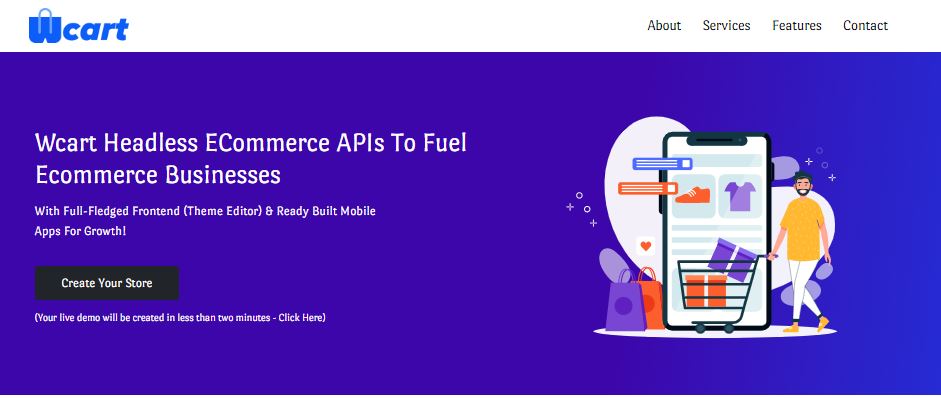
Wcart is a powerful ecommerce web development platform that offers a comprehensive set of features to fuel ecommerce businesses. One of the standout features of Wcart is its headless ecommerce APIs, which allow for seamless integration with a variety of front-end applications. This makes it easier than ever for businesses to build custom ecommerce experiences that are tailored to their specific needs.
Additionally, Wcart comes equipped with a full-fledged frontend theme editor, giving users complete control over the look and feel of their online store. And for businesses looking to expand their reach even further, Wcart offers ready-built mobile apps that are optimized for growth. With Wcart, ecommerce businesses have all the tools they need to succeed in today’s competitive online marketplace.
Webnexs

Webnexs offers an innovative Headless eCommerce platform that allows businesses to go unlimited in their online sales capabilities. With an enterprise-level omnichannel experience, Webnexs makes it easy for businesses to set up, manage, and sell across infinite channels.
Whether it’s on a website, mobile app, social media, or any other platform, Webnexs has the tools to help businesses succeed. With APIs to create a dynamic and differentiable shopping platform, businesses can be faster to market and stay ahead of the competition. The Headless eCommerce platform from Webnexs is the perfect solution for businesses that want to take their online sales to the next level.
Read More: How to Choose the Best Online Store Builders
Factors to Consider When Selecting an Ecommerce Platform
When selecting an ecommerce platform, consider the following factors:
- Cost: Compare the cost of different ecommerce platforms, including transaction fees, hosting fees, and any other additional fees.
- Scalability: Choose an ecommerce platform that can accommodate the growth of your business.
- Security: Look for an ecommerce platform that offers robust security features, including SSL certificates and fraud detection.
- Support: Choose an ecommerce platform that offers excellent customer support, including technical support, tutorials, and community forums.
Pros and Cons of Self-Hosted and Hosted Ecommerce Platforms
Accordingly, there are two types of ecommerce platforms: self-hosted and hosted. Here are the pros and cons of each:
- Self-Hosted: Generally self-hosted ecommerce platforms allow you to have complete control over your website, including design and functionality. However, they require more technical expertise and may have higher maintenance costs.
- Hosted: Hosted eommerce platforms are easier to set up and maintain, but they may have limited customization options and require you to pay ongoing fees.
Designing Your Ecommerce Store
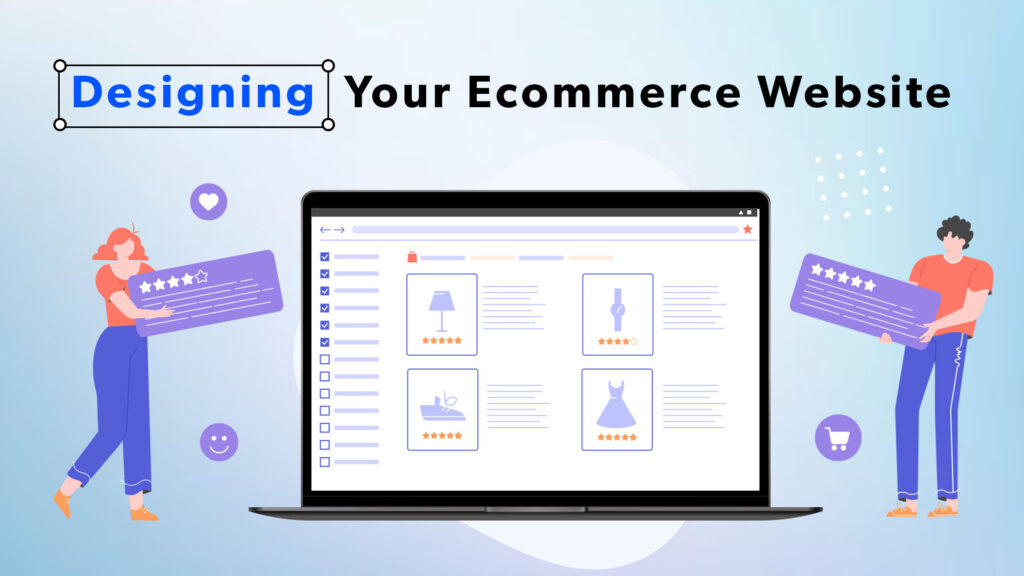
Before designing your ecommerce website, consider your branding, target audience, and products. Certainly your website design should be consistent with your brand identity and appeal to your target audience. Some key elements to consider when designing your ecommerce website include:
- Navigation: Make it easy for your customers to find what they are looking for by organizing your products into categories and using clear, intuitive navigation.
- Visuals: Use high-quality images and videos to showcase your products and create an engaging visual experience.
- Checkout process: Make the checkout process as simple and streamlined as possible to reduce cart abandonment rates.
Importance of Website Design in Ecommerce
Comparatively website design plays a crucial role in the success of your ecommerce business. A well-designed ecommerce website can:
- Build trust: A professional, well-designed website can help build trust with your customers and increase their confidence in your brand.
- Enhance user experience: A user-friendly website design can make it easier for customers to find what they are looking for and complete purchases.
- Increase conversions: An effective ecommerce website design can increase conversions by encouraging customers to add products to their cart and complete their purchase.
Visit Here: Why Your Ecommerce Business Needs a Stunning Website Design
Best Practices for Designing an Effective Ecommerce Website
To design an effective ecommerce website, consider the following best practices:
- Use a responsive design: Your ecommerce website should be optimized for all devices, including desktops, tablets, and smartphones.
- Keep it simple: A cluttered or confusing website design can turn off customers and decrease conversions. Keep your design simple and easy to navigate.
- Use high-quality visuals: High-quality images and videos can showcase your products and create an engaging visual experience for customers.
Tips for Creating a User-Friendly Ecommerce Website
To create a user-friendly ecommerce website, consider the following tips:
- Optimize your website speed: A slow-loading website can frustrate customers and lead to increased bounce rates. So, optimize your website speed by compressing images, minimizing code, and using a fast web host.
- Simplify your checkout process: A complicated checkout process can lead to cart abandonment. Simplify your checkout process by reducing the number of steps and requiring only essential information.
- Provide clear product information: Make it easy for customers to find the information they need about your products, including descriptions, pricing, and availability.
Read More: The Do’s and Don’ts of Ecommerce Web Design
Developing Ecommerce Web Functionality
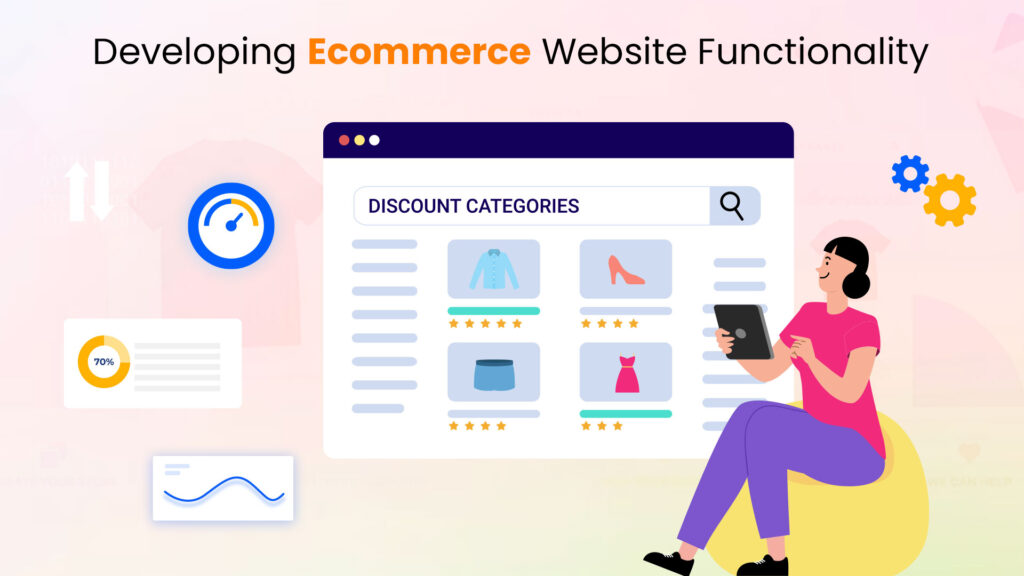
Developing an ecommerce website that meets your customers’ needs requires careful planning and attention to detail. The functionality of your website is undoubtedly significant to the success of your ecommerce business. In this section, we will discuss the key features and best practices to consider when developing your ecommerce website’s functionality.
Overview of Key Ecommerce Website Features
An ecommerce website’s functionality should meet the needs of both the customer and the business owner. The following are some additionally development features that every ecommerce store should have:
- Product Catalog: A comprehensive catalog of all the products offered on your ecommerce website. Each product should have a detailed description, images, price, as well as other relevant information.
- Shopping Cart: A shopping cart feature allows customers to add items to their cart and proceed to checkout when they are ready to purchase.
- Payment Gateway: An ecommerce website should have a secure and reliable payment gateway that accepts multiple payment options, such as credit cards, PayPal, and other online payment methods.
- Order Management: In addition, an order management system allows business owners to manage orders, track shipments, and handle customer support inquiries.
Best Practices for Developing Ecommerce Store Functionality
When developing your ecommerce website’s functionality, it’s essential to follow best practices to ensure that your website is easy to use and meets your customers’ needs. Here are some best practices to consider:
- User-Friendly Navigation: Ensure that your website’s navigation is simple and easy to use. Use clear and concise labels for each menu item and make sure that the website is easy to navigate on different devices.
- Mobile Responsiveness: With the increasing number of mobile users, it’s essential to have a website that is optimized for mobile devices. As a result your website should be responsive and provide an excellent user experience on mobile devices.
- Search Functionality: A search bar is essential for ecommerce websites, allowing customers to quickly find products they are looking for.
- Website Speed: The loading time of your ecommerce store is critical to providing an excellent user experience. Ensure that your website is optimized for fast loading times to avoid customers leaving due to slow page speed.
Tips for Creating a Seamless Checkout Process
The checkout process is another key point of an ecommerce web development. A seamless and straightforward checkout process can help to reduce cart abandonment rates and increase conversions. Here are some tips to consider:
- Guest Checkout: Allow customers to check out as guests to reduce friction during the checkout process.
- Multiple Payment Options: Provide multiple payment options, including credit cards, PayPal, and other online payment methods.
- Clear Shipping Information: Provide clear shipping information, including estimated delivery times and shipping fees, to avoid any confusion or surprises during the checkout process.
- Easy-to-Use Checkout Form: Finally make sure that your checkout form is easy to use and optimized for mobile devices.
Visit Here: Ultimate Guide to Building a Ecommerce Website from Scratch
Optimizing Ecommerce Website Performance
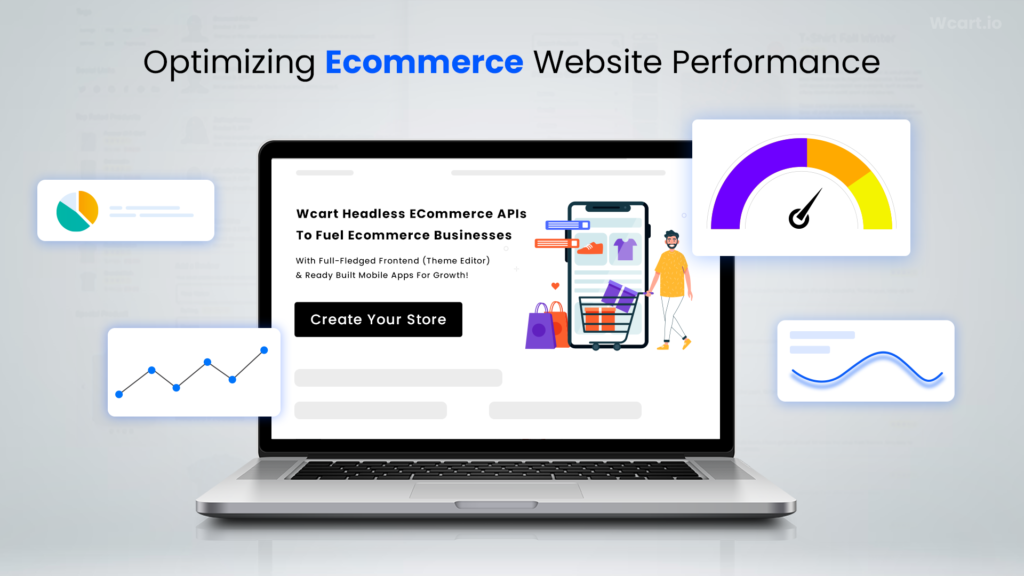
Optimizing website performance is a crucial aspect of ecommerce web development that can significantly impact user experience and ultimately affect your online business’s success. It is important to realize that poor website performance can lead to slow page load times, high bounce rates, and reduced conversion rates. Therefore, it is essential to optimize your ecommerce website’s performance to ensure a smooth and seamless user experience.
Importance of Website Performance in Ecommerce
Website performance plays a most important role in ecommerce success. Studies have shown that visitors are more likely to abandon a website that takes more than three seconds to load, leading to lost sales opportunities. Slow page load times can also negatively impact your website’s search engine rankings, which can further decrease your website’s visibility and traffic. Additionally, poor website performance can lead to a negative brand image, ultimately harming your business’s reputation.
Tips for Optimizing Website Load Speed
Page load speed is also equally important in the aspects of website performance. Here are some tips to optimize your ecommerce website’s load speed:
- Optimize images: Large image files can significantly impact website load times. Therefore, it is essential to compress images and use the appropriate file format to reduce file size.
- Minimize HTTP requests: Each element on a webpage requires a separate HTTP request, which can slow down page load times. To reduce the number of HTTP requests, minimize the number of on-page elements and combine multiple files into a single file.
- Use a content delivery network (CDN): A CDN can help improve website load times by distributing website files across multiple servers.
- Minify code: Minifying your website’s code can help reduce the file size and improve website load times.
Best Practices for Improving Website Usability and Accessibility
In addition to optimizing load speed, improving website usability and accessibility is also crucial for ecommerce success. Here are some best practices for improving website usability and accessibility:
- Keep the design simple: A cluttered design can negatively impact website usability. Therefore, it is essential to keep the design simple and intuitive, with clear navigation and a consistent layout.
- Provide detailed product information: Providing detailed product information can help customers make informed purchasing decisions and improve the user experience.
- Use responsive design: With the increasing use of mobile devices, it is equally important to use responsive design to ensure that your ecommerce website is accessible and user-friendly on all devices.
- Ensure website accessibility: Make sure that your ecommerce website is accessible to people with disabilities. This includes providing alternative text for images, using descriptive link text, and ensuring that website forms are keyboard accessible.
Implementing Ecommerce Website Marketing Strategies
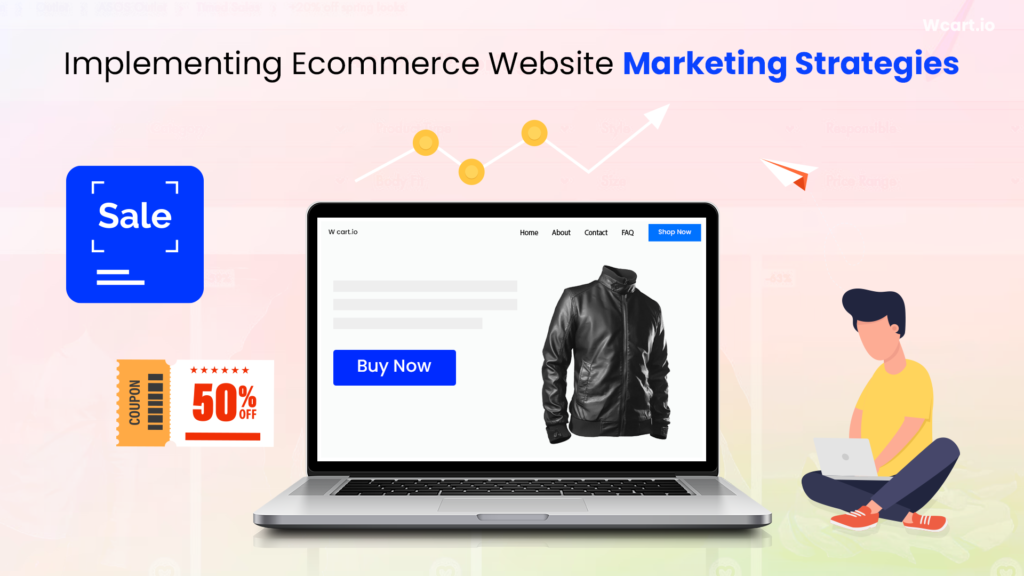
After development marketing is most important for any ecommerce web to attract potential customers and drive sales. In this section, we will discuss various ecommerce marketing strategies that can help in general to achieve your business goals.
Overview of Ecommerce Marketing Strategies
There are numerous marketing strategies that businesses can use to increase their ecommerce website traffic, conversions, and sales. Some popular strategies include:
- Search Engine Optimization (SEO): Optimizing your website’s content and structure to improve its ranking in search engine results pages (SERPs).
- Pay-Per-Click (PPC) Advertising: Running paid ads on search engines and social media platforms to target specific keywords and audience demographics.
- Content Marketing: Creating high-quality content, such as blog posts, videos, and infographics, to attract and engage potential customers.
- Email Marketing: Sending personalized and targeted emails to promote your products, discounts, and events.
- Social Media Marketing: Building a strong social media presence on popular platforms, such as Facebook, Instagram, and Twitter, to connect with your audience and showcase your brand.
Best Practices for Implementing Ecommerce Marketing Strategies
To ensure the success of your ecommerce marketing strategies, it’s crucial to follow some best practices:
- Define your target audience and their needs: Understand your audience’s preferences, pain points, and purchase behavior to create relevant and effective marketing campaigns.
- Set SMART goals and objectives: Make sure your goals are Specific, Measurable, Attainable, Relevant, and Time-bound.
- Conduct market research and competitor analysis: Stay up-to-date with the latest market trends and analyze your competitors’ strengths and weaknesses to identify opportunities and gaps in your marketing strategy.
- Use analytics and data tracking tools: Monitor and measure your website traffic, conversion rates, and customer behavior to optimize your marketing efforts and improve your ROI.
- Test and optimize your campaigns: Continuously experiment with different marketing channels, messages, and visuals to find the most effective combination for your business.
Measuring the Success of Ecommerce Marketing Campaigns
To measure the success of your ecommerce marketing campaigns, you should track the following metrics:
- Website traffic: The number of visitors to your website.
- Conversion rate: The percentage of visitors who take a desired action, such as making a purchase or filling out a form.
- Average order value (AOV): The average amount of money spent per order.
- Return on investment (ROI): The ratio of your marketing spend to your revenue.
- Customer lifetime value (CLV): The estimated revenue a customer will generate for your business over their lifetime.
By regularly analyzing above all metrics, you can identify areas for improvement and optimize your marketing strategies to achieve your business objectives.
Ensuring Ecommerce Website Security and Compliance

In today’s digital age, where data breaches and cyber-attacks have become common, it’s important to ensure that your ecommerce website is secure and compliant with regulations. This not only protects your customers’ sensitive information but also helps build trust and credibility for your brand. Here are some key considerations for ensuring ecommerce website security and compliance.
Importance of Website Security in Ecommerce
Website security is crucial for any ecommerce business, as it directly impacts the safety and privacy of customer information. Without proper security measures in place, your website is vulnerable to hacking, phishing attacks, and other forms of cybercrime. This can lead to data theft, financial loss, and damage to your brand reputation. In addition, failing to comply with industry regulations and standards can result in legal and financial penalties.
Best Practices for Ensuring Website Security
To ensure the security of your ecommerce website, it’s important to follow best practices such as:
- Secure your website with SSL/TLS encryption: This encrypts data transmitted between the web server and user’s browser, making it more difficult for hackers to intercept and steal data.
- Use strong and unique passwords: Encourage your customers to use strong and unique passwords, and in addition to that ensure your website’s administrative accounts are protected with strong passwords as well.
- Regularly update software and plugins: Outdated software and plugins can leave your website vulnerable to security vulnerabilities. Ensure that your website’s software and plugins are regularly updated to their latest versions.
- Implement firewalls and malware protection: Firewalls and malware protection software can help prevent attacks and detect any malicious activity on your website.
- Conduct regular security audits: Regularly auditing your website’s security can help identify vulnerabilities and potential risks, and allow you to take proactive measures to mitigate them.
Overview of Ecommerce Compliance Regulations
In addition to ensuring website security, ecommerce businesses must also comply with industry regulations and standards. These include:
- Payment Card Industry Data Security Standard (PCI DSS): This standard applies to all businesses that accept credit card payments, and outlines security requirements for protecting cardholder data.
- General Data Protection Regulation (GDPR): This regulation applies to businesses that collect and process personal data of individuals in the European Union (EU), and outlines requirements for data protection and privacy.
- California Consumer Privacy Act (CCPA): This act applies to businesses that collect and process personal data of California residents, and outlines requirements for data protection and privacy.
- Children’s Online Privacy Protection Act (COPPA): This act applies to businesses that collect personal information from children under the age of 13, and outlines requirements for obtaining parental consent and protecting children’s privacy.
Compliance with these regulations can help protect your customers’ privacy and avoid legal and financial penalties. It’s important to stay up-to-date with the latest regulations and ensure that your ecommerce website is compliant with them.
Launching Your Ecommerce Website
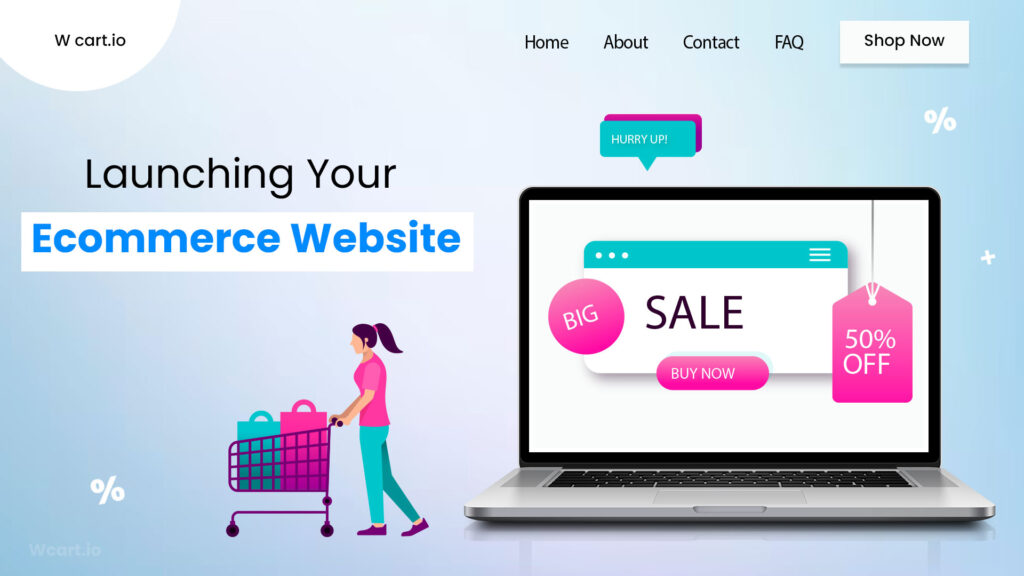
Launching an ecommerce website can be an exciting yet daunting task. Likewise, it requires a lot of planning, effort, and attention to detail to ensure a smooth and successful launch. In this section, we will discuss some key steps to take when launching your ecommerce website.
Pre-launch Checklist for Your Ecommerce Website
Before launching your ecommerce website, there are several things you should check to ensure everything is in order.
- First thing to remember, ensure that your website design is visually appealing and user-friendly. Make sure all links and buttons are functioning correctly and that your website is responsive and accessible on all devices.
- Additionally, test your website’s functionality, including the checkout process and payment gateway. Check to ensure that all products are properly categorized and that customers can easily find what they are looking for. You should also set up tracking and analytics tools to monitor website traffic and user behavior.
- Finally, make sure you have taken all necessary steps to ensure website security and compliance with relevant regulations. This includes implementing SSL certificates, ensuring secure payment gateways, and complying with data protection regulations such as GDPR or CCPA.
Tips for Promoting Your Ecommerce Website Launch
Once your ecommerce web development is ready to launch, it’s important to promote it effectively to drive traffic and sales. Here are some tips for promoting your ecommerce website launch:
- Use social media: Share your website launch announcement on social media platforms such as Facebook, Twitter, Instagram, and LinkedIn. Use relevant hashtags and encourage your followers to share your post.
- Email marketing: Send an email to your existing subscribers and customers announcing the launch of your ecommerce website. Offer exclusive discounts or promotions to incentivize them to visit your website.
- Influencer marketing: Partner with influencers or bloggers in your industry to promote your website launch to their followers.
- Paid advertising: Use paid advertising platforms such as Google Ads, Facebook Ads, or Instagram Ads to promote your website launch.
Common Pitfalls to Avoid When Launching Your Ecommerce Website
When launching your ecommerce website, there are some common pitfalls you should avoid. These include:
- Poor website performance: Make sure your website loads quickly and is accessible on all devices to provide a positive user experience.
- Inadequate product descriptions: Ensure that your product descriptions are clear, accurate, and informative to help customers make informed purchasing decisions.
- Insufficient payment and shipping options: Offer multiple payment and shipping options to cater to different customer preferences.
- Lack of customer support: Provide reliable customer support through various channels such as email, phone, or live chat.
Visit Here: Development Of Ecommerce Website – From Concept to Launch
Growing Your Ecommerce Business

At first growing your ecommerce business requires a combination of strategy, patience, and execution. There are various ways to increase website traffic, sales, customer retention, and expand your business. In this section, we will discuss some tips and best practices for growing your ecommerce business.
Tips for increasing website traffic and sales
- Search engine optimization (SEO): SEO is a powerful tool for increasing website traffic and sales. By optimizing your website for search engines, you can improve your website’s visibility and attract more potential customers to your site. Some of the best SEO practices include keyword research, meta descriptions, alt tags, and internal linking.
- Paid advertising: Paid advertising such as Google Ads, Facebook Ads, and Instagram Ads can help increase website traffic and sales by targeting specific audiences. It is important to develop a well-planned advertising campaign that aligns with your business goals and target audience.
- Content marketing: Content marketing involves creating and sharing valuable content to attract and retain customers. This can include blog posts, videos, infographics, and social media posts. By providing relevant and informative content, you can establish your brand as an industry authority and attract more potential customers to your website.
Best practices for customer retention and loyalty
- Offer excellent customer service: Providing excellent customer service is crucial for retaining customers and building brand loyalty. Make sure to respond to customer inquiries promptly and address any issues or concerns they may have.
- Personalize the customer experience: Personalizing the customer experience can help increase customer satisfaction and loyalty. This can include personalized product recommendations, targeted email marketing, and loyalty programs.
- Encourage customer feedback: Encouraging customer feedback can help you identify areas for improvement and address any issues customers may have. This can include online reviews, surveys, and feedback forms.
Strategies for expanding your ecommerce business
- Diversify your product offerings: Diversifying your product offerings can help you reach new customers and expand your business. Consider adding complementary products or expanding into new product categories.
- Expand your target audience: Expanding your target audience can help you reach new customers and increase sales. Consider targeting new geographic regions or demographic groups.
- Collaborate with other businesses: Collaborating with other businesses can help you reach new audiences and increase brand awareness. Consider partnering with other businesses for joint marketing campaigns or cross-promotion.
Read More: Tips for Developing an Ecommerce Website That Will Skyrocket Your Sales
Conclusion
In conclusion, ecommerce web development is a complex process that requires careful planning and execution. A successful ecommerce website should be designed with the user in mind, have a seamless checkout process, be optimized for performance and security, and have effective marketing strategies in place. By following the best practices outlined in this guide, you can ensure that your ecommerce website is set up for success and growth.
It’s important to keep in mind that ecommerce web development is an ongoing process that requires continuous improvement and adaptation to stay ahead of the competition. Wcart will help you to build a successful online store. Book A Demo.
Frequently Asked Questions (FAQs)
1. What is the most important feature of an ecommerce website?
The most important feature of an ecommerce website is a seamless user experience. Customers should be able to easily navigate the website, find the products they are looking for, and complete their purchase with minimal effort.
2. What is the best ecommerce platform for a small business?
The best ecommerce platform for a small business will depend on a variety of factors, including budget, the number of products being sold, and the level of customization required. Some popular options include Wcart and Webnexs.
3. How can I optimize my ecommerce website for search engines?
To optimize your ecommerce website for search engines, you should focus on creating high-quality, relevant content that includes keywords related to your products and industry. You should also ensure that your website is structured properly, with clear, descriptive URLs, meta tags, and headings.
4. How can I increase my website’s conversion rate?
There are many ways to increase your website’s conversion rate, including improving website speed, simplifying the checkout process, offering free shipping, and providing customer reviews and testimonials. It’s also important to analyze your website’s data regularly to identify areas for improvement.
5. How often should I update my ecommerce website?
It’s important to update your ecommerce website regularly to ensure that it remains relevant and engaging for your customers. This may involve updating product descriptions and images, adding new products or categories, and making changes to the website’s design or functionality. Aim to make updates on a regular basis, whether that’s weekly, monthly, or quarterly.




Leave a Reply